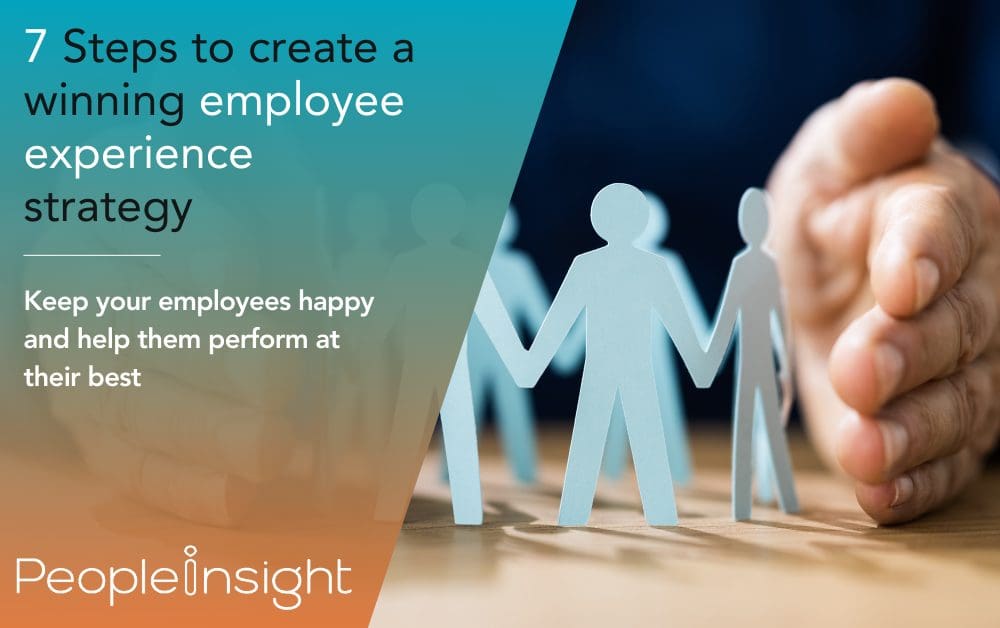
Today, companies need to focus on more than just compensation and benefits to keep their workforce engaged. A well-structured and well-thought-out employee experience strategy is more important than ever before, and can make all the difference when it comes to attracting, retaining and motivating top talent. From recruitment to exit, every stage of the employee lifecycle matters in shaping an individual’s perception of the company.
Let’s take a look at seven key steps you can take to create and maintain a rewarding employee experience strategy, ensuring your workforce remains engaged and productive from day one.
Related: check out our employee experience mapping whitepaper
An employee experience strategy is a deliberate approach that focuses on improving the entire journey an employee takes with an organisation. It covers every touchpoint, starting from recruitment and onboarding, through daily interactions, career development and, finally, to exit. The goal is to create a seamless, positive employee experience that not only enhances productivity but also promotes loyalty and engagement.
This strategy isn’t simply about perks or benefits — it’s about creating an environment that empowers employees to do their best work while feeling supported and valued. Research shows that companies with strong employee experience strategies tend to have lower turnover rates and higher levels of engagement so clearly, focusing on employee experience directly impacts business success.
Want a fun read? Have a look at our employee experience glossary
A well-crafted employee experience strategy is important for a number of reasons. Firstly, a good strategy has the potential to boost employee retention. According to a study by Forbes, companies that invest in their employees’ experience see up to a 40% reduction in voluntary turnover rates. This means fewer costs associated with recruitment and training, as well as higher employee morale.
Secondly, a great employee experience can significantly improve levels of engagement and productivity. Engaged employees are not only more motivated but also more likely to take ownership of their work. They are advocates for your company, contributing to a stronger employer brand. In today’s competitive talent market, this has the potential to make all the difference when it comes to attracting high-performing employees.
One of our favourite business benefits of considering and implementing a winning employee experience strategy is that it can nurture creativity and innovation. When employees feel heard, valued and empowered, they are more likely to contribute new ideas, collaborate more effectively and drive business growth — what’s not to love?
Creating a strong employee experience strategy requires commitment, empathy and a clear understanding of what matters most to your employees. The team here at People Insight are all experienced and passionate about this area, so we’ve put our heads together and come up with seven steps you can implement to develop a winning strategy in your business.
Related: What are moments that matter and why are they important?
The employee experience doesn’t start on an employee’s first day; it begins the moment they interact with your company. This includes the recruitment process. A streamlined, user-friendly application process is essential to leaving a good first impression.
Ask yourself:
A poor recruitment experience can damage your reputation and deter talented people from joining your team. Remember, platforms like Glassdoor allow candidates to share their experiences, making it more important than ever to get this step right.
Onboarding is one of the most important phases of the employee experience. A solid onboarding process can increase employee retention and engagement, setting the tone for long-term success. During onboarding, employees should feel welcomed and equipped with the tools they need to perform their jobs effectively.
The onboarding phase should include training, personal welcome messages and comprehensive introductions to the company’s mission, values and culture. Providing employees with a personalised welcome pack can go a long way to enhancing their initial experience and impression of the company. Don’t forget, managers play a hugely influential role in onboarding. Setting the right tone from day one can make a lasting impact.
While compensation matters, it’s not enough to retain top talent. Employees today seek meaning and purpose in their work. They want to feel like they are making a difference and contributing to something bigger than themselves.
To create a meaningful experience, be transparent about your organisation’s mission and goals, and demonstrate how each employee’s role contributes to the bigger picture. Regularly share updates on the company’s progress and how it aligns with your employees’ efforts. You can also provide opportunities for continuous learning, foster a sense of community, and encourage managers to give frequent feedback. These factors contribute to an overall sense of purpose, which increases motivation and loyalty.
Employees thrive on recognition. A lack of appreciation can lead to disengagement, while recognition can motivate employees to perform at their best. According to one survey, 69% of employees say they would work harder if their efforts were better recognised.
Create a culture of appreciation by encouraging managers to frequently acknowledge the hard work and contributions of their team members. Implement formal recognition programmes, such as monthly awards or spot bonuses, to reward notable efforts. Simple acts of appreciation can go a long way in keeping employees motivated and committed to their roles.
Related: Check out these employee appreciation ideas
Career growth is a key factor in employee engagement. Millennials and Gen Z workers, in particular, see continuous learning and development as crucial to their career success. Providing opportunities for growth not only keeps your employees engaged but also shows that you are invested in their long-term success.
Regularly meet with employees to discuss their career goals and development plans. Provide training, workshops, or even mentorship opportunities to help them upskill and achieve their ambitions. This creates a culture of learning that benefits both the employee and the company.
Your employee experience strategy should be a dynamic process, regularly informed by feedback. Conducting frequent lifecycle surveys allows you to gauge engagement levels, identify potential pain points and track changes over time. Surveys are particularly useful during times of organisational change, as they can highlight shifts in employee morale and wellbeing.
Gathering regular feedback shows employees that you care about their opinions and are committed to improving their work environment.
Conducting surveys is only the first step. For surveys to be effective, you must act on the feedback you receive. Analysing the results and implementing changes based on employee suggestions can significantly improve the workplace experience.
Whether it’s introducing new benefits, improving communication, or adjusting workloads, taking action demonstrates that employee feedback matters. This, in turn, fosters a culture of trust and continuous improvement.
A successful employee experience strategy goes beyond surface-level perks; it’s about understanding the needs and aspirations of your employees at every stage of their journey with your company. From recruitment to onboarding, recognition to development, each phase plays a vital role in shaping a positive experience. By following these seven steps, you can create a work environment where employees feel valued, motivated, and inspired to contribute to your company’s success.
Remember, investing in your employees is investing in the future growth and stability of your organisation.
Here at People Insight, we take a human, holistic approach to employee engagement surveys. Our surveys are tailor-made, specific to your company’s needs — we’ll also help you implement meaningful change with professional and experienced consulting services. Get in touch today to find out how we can help your business.

